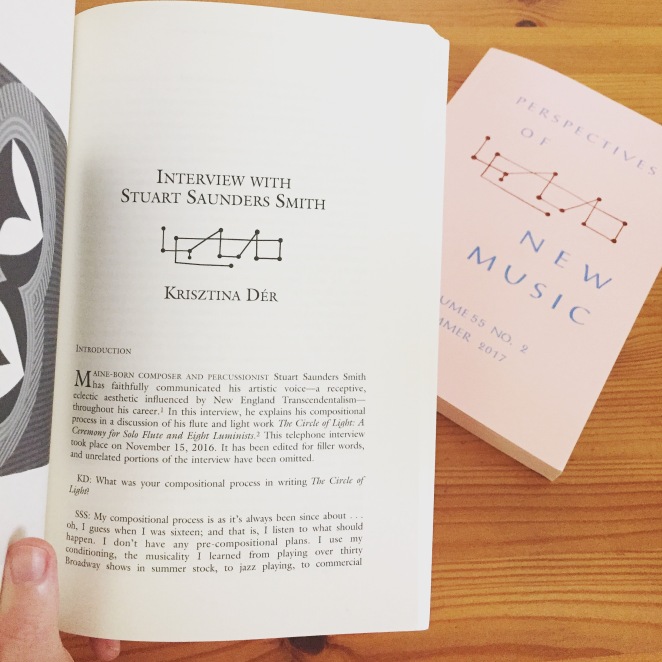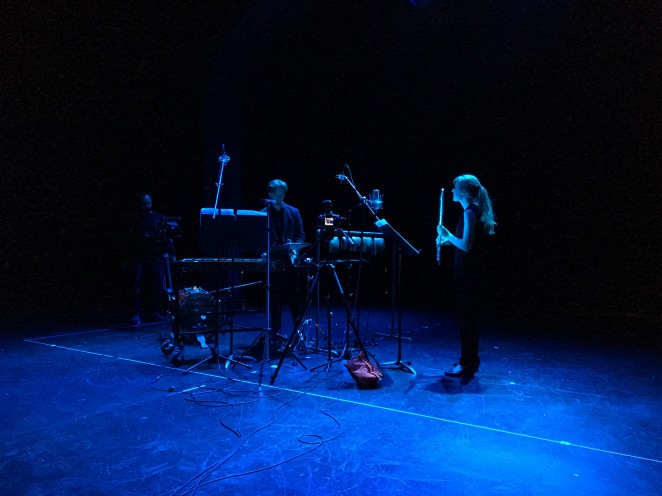Nick Rich is a North Carolina-based guitarist, composer, and songwriter. While we were both in the middle of our Master’s studies at UNCSA, he composed his Lennon Variations for the UNCSA flute ensemble: my introduction to his compositional voice. Influenced by his upbringing in a family that played Country-Western, Bluegrass, and Rock, Nick’s music explores the intersections of popular and experimental music. In Lennon Variations, he quoted John Lennon’s “Give Peace a Chance,” fragmenting, overlapping, and percolating the melody through the ensemble as it is slowly transformed into its recognizable, unified self. More recently, he composed a folk-flavored song cycle, Little Simple Song, funded by the Kenan Institute of the Arts.
I am so honored Nick has contributed to my flute/light project with “This is a picture of.” Its lighting concept (developed by Jonathan Wall) is unexpected and compelling, and its coy references to bluegrass (featuring pre-recorded samples by Rich Hartness) are downright fun. I can’t wait to premiere it at UMBC later this month! Until then, Nick generously answered some questions about the piece for me to share with you!
KD: What was your compositional process in writing “This is a picture of”?
NR: On the conceptual side of things, I spent a lot of time talking with Jonathan and Rich. Jonathan and I have done about half a dozen pieces together at this point, and we have a pretty productive working process that involves trying out and throwing out lots of ideas. His perspective is very important to me, even on pieces that we don’t work on together. Rich and I had several conversations that were much less about the art and more about the concepts: technology, communication, social media, accessibility, etc.
On the technical side of things, our piece centers around a photograph of Rich playing fiddle and his partner Tolly playing guitar. That photo generated the music both symbolically and literally. I spent an evening playing music with Rich and recorded it, later developing the electronic backing track from the sound of his fiddle. The music I wrote for the live instrumentalists starts out rather experimental but moves closer to folk as the piece progresses. The text was generated by feeding that photo, and small excerpts from it, into various kinds of AI photo-captioning software. The singers sing about the photo from the software’s perspective. Finally, Jonathan subjected the photo to neural network software, as well as more traditional kinds of image processing, to create his projection.
KD: Did any particular ideas, concepts, or stories inspire your piece?
NR: Rich and I met at a Bluegrass/Old Time convention about a year and a half ago. We bonded over some vintage guitars that I had with me, and shortly after that found that we also share a fascination with electronic music and technology. He’s great with technology in general, has lots of programming experience, and messed around with early synthesizers and voltage control devices a while back. So the idea of doing some sort of piece combining digital media and folk music makes sense in the context of our friendship and shared interests. As we talked more over the months, I learned about his journey with visual impairment and accessibility, and my mind and perspective really opened. Coincidentally, around the time you asked me about doing a piece, I saw some conversations on Twitter about photo captions and accessibility, and the ideas for the piece started falling into place. I asked Rich if he’d be open to doing a piece that incorporated these themes, and he was.
KD: Do you have any previous experience with lighting art? Or, had you thought about the integration of music and light before my commission?
NR: Jonathan and I have done a few video pieces, but we haven’t used abstract lighting art as a medium. But, the idea wasn’t completely foreign. I worked a little bit in lighting design for a concert venue, which I enjoyed. In the live pop and rock world, lighting is a given–although, of course, it most often “accompanies” the music rather than occupying a central place in the art-making. Over the years I had seen lots of contemporary and experimental pieces that use light as a component in one way or another. Jonathan’s language with video is already fairly abstract and non-narrative, so I knew he would be willing and able to deliver a true “flute+light” piece in which all the components work together. I love that we were able to come up with a process in which the text, backing track, live music, and lighting all emerged from the same source.
KD: To what degree can the work be adapted for alternative performance spaces?
NR: In principle I’m in favor of adaptability. With this particular piece, I’ve thought about the possibility of a slimmer version–for example, solo flute+electronics. But I would have to think through it carefully; I generally don’t like “canned” sounds in the electronics, or pre-recorded versions of instruments that could be represented live. With the backing track as it is, there’s a special reason that the fiddle is represented electronically: it goes through a symbolic transformation from being heavily obscured and processed, to being fragmented and looped, to being fully revealed. If I were to somehow include the other instruments and voices in the backing track, I would want to mess them up quite a bit, so that they’re part of that process also.
KD: Would you consider composing for music and light intermedia again?
NR: I would definitely do this kind of intermedia project again. The combination of human performers and some technological component excites me more than either realm individually.











 of my professors passed my name along to the Chair of the
of my professors passed my name along to the Chair of the  as
as 









 Time sure does seem to fly when you’re having fun, and the last months have been quite the whirlwind! I auditioned for the
Time sure does seem to fly when you’re having fun, and the last months have been quite the whirlwind! I auditioned for the 
 Once upon a time, I was given the opportunity to perform a work called Improvisation for Flute and Computer by
Once upon a time, I was given the opportunity to perform a work called Improvisation for Flute and Computer by  work evolved, the opportunity arose for the piece to become multimedia artwork with the
work evolved, the opportunity arose for the piece to become multimedia artwork with the

